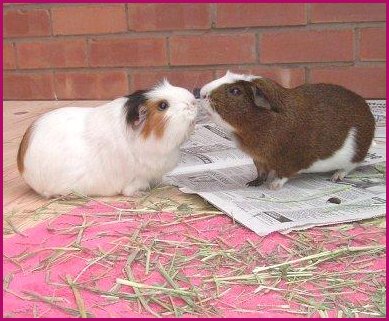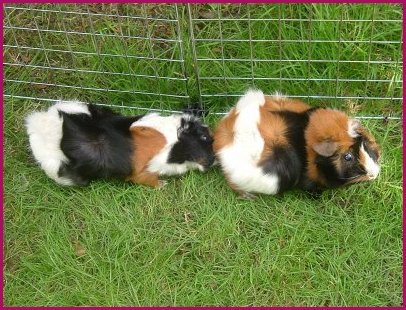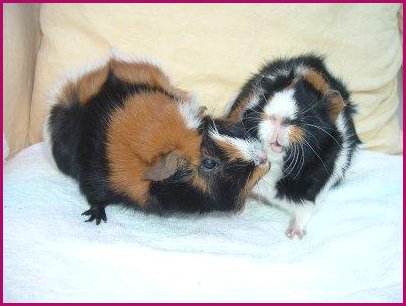|
 Guinea Pigs and Companionship
Guinea Pigs and Companionship
When it comes to keeping guinea pigs, questions about their social life are always high up on the list
for concerned owners. I hope this section of my site answers some of your questions. Because everyone can have
different experiences, I've also
placed links at the bottom of the page for additional reading. Here I will explain why guinea pigs
need a cage mate, introducing guinea pigs to each other, what to expect and what to do when introductions don't run smoothly.
I'll explain why mixing rabbits and guinea pigs together is dangerous.
I'll also tell you about my own guinea pigs introductions and how they interact with each other and more.
Quarantine Period
If you have brought two guinea pigs home from the same place, then there is no need to quarantine them for a couple of weeks, unless they
are going to be joining your existing guinea pigs.
If you have brought a guinea pig home to be introduced to your existing guinea pig or herd, you need to quarantine the
new guinea pig for at least two weeks. A few guinea pig illnesses can incubate for a while, so a quarantine period of two to three weeks will
allow enough time for an illness to show itself, should there be one ready to surface.
Keep
the newcomer in another room, away from your other guinea pigs. Always wash your hands after handling the newcomer to hopefully
avoid passing anything on to your other piggies.
Sexing guinea pigs
Of course before you attempt to introduce guinea pigs to each other, you need to be sure 100% that you know the sex of your guinea pigs.
Please visit the following links below. If your still not sure, ask your vet. Please don't
rely on pet shops, many pet shops do get the gender wrong. Some even allow mixed sexes to interact and live together so some sows may already be pregnant.
Cavy Spirits-Sexing Guide
Wheekies-Sexing Guinea Pigs
Hey, Pigs!-How to tell the sex of your Cavy
Reason why guinea pigs need a cage mate
In the wild, guinea pigs live in herds,
consisting of usually one dominant adult male,
several females and their babies. Guinea pigs would much rather live as a pair or a herd, they feel that there
is safety in numbers. With a succesful pairing or group, they also enjoy the company of their own kind, communicating
and interacting with each other. Both males and females have a strict dominance ranking.
The domestic guinea pigs act in much the same way as
wild guinea pigs.
Like the wild guinea pig, the domestic guinea pig thrives on having company of their own kind. Some guinea pigs
may form very close relationships, others may not, but most are happy to have company and know that
they aren't on their own. A guinea pig that has lived on their own, but is then
introduced to another guinea pig that they like,
often the changes in the lone guinea pig can be remarkable. They will run-around more, follow each other, they communicate with each other,
some will even groom and sleep cuddled up next to each
other. Once the ranking order has been sorted out and they settle in together, you'll see how happy they are.
Some people say that their lone guinea pig is never lonely, but nobody can be with
them 24 hours aday, plus humans can't speak a guinea pigs language. Guinea pigs really do thrive once a paring or group is established. Remember that 2 or more guinea pigs together feel less nervous
than one guinea pig living on their own.
There are also advantages for you as a guinea pig owner. You will get to see
so many different kinds of behaviour when they interact with each other. Some behaviour just wouldn't be seen with
a lone guinea pig. Playing 'following the leader' tug of war with their vegetables, grooming each other, sniffing,
snuggling up together, so much more that a lone guinea pig
just wouldn't be able to do. One statement that crops up is "my guinea pig won't
bond with me if they have a cage mate". This just isn't true. As long as your gentle and caring towards your guinea pigs,
they will bond with you. You may also notice that your guinea pig will become more confident and relaxed so that is an added bonus for
you and your guinea pig.
Do all guinea pigs want to be the boss?
From my own experience, my answer would be no. Some guinea pigs aren't interested in becoming the dominant guinea pig of a pair or group and just want to be friends. They will of course go through certain rituals to determine their
ranking positions, but generally they will want to just be friends fairly quickly.
However, a very friendly guinea pig will only be happy if they aren't being constantly bullied by a dominant piggy. I will
explain about the effects of bullying further down the page. If a dominant guinea pig can see they aren't being challenged for leadership, then the pairing is more likely to
be successful. Things are more likely to go wrong if you have two guinea pigs that both want to be the boss. Some will settle their position in the group without a fight, however some guinea pigs
just won't accept second position and will fight. This applies to boars and sows.
Territorial Piggies
Remember one main trigger for arguments is disputes over territory. Its always best to introduce guinea pigs on neutral territory, an area where they haven't been before.
If you look at this from a guinea pigs point of view, it wouldn't be very nice if someone moved into your house who you hadn't even met before would it?
So you can see why territory disputes can break out. You are more likely to have a successful pairing when your guinea pigs are introduced on neutral territory. Caution: Speaking from
experience, some guinea pigs can get along just fine on neutral territory, but then things may change when
you introduce the new comer into the existing guinea pigs territory. Be prepared for this to happen, however there are many ways to try and avoid this happening. I will explain about how to introduce guinea pigs further down the page.
Boars Living Together
Boar guinea pigs can indeed live happily with each other, but a pair of boars can be more successful at being introduced than 3 or more boars. Having said that
I do know of a few people who have a group of boars happily living in the same cage.
A key part for successfully introducing boars is
providing them with a spacious cage.
Personalities also play a key role for successful introductions. Some males
are less dominant than others. Some want to be the alpha male, others are more submissive or simply aren't interested in taking
the leadership role. A well known trigger for boars to start fighting is
when they can smell sows in
the area. So if you do have sows, keep them far enough away so the boars can't smell their
presence. Even two boars who have been happily living together for months may fight over females.
Boar Options
Ideally two young
boars either from the same litter or not can work out well. An older boar
may also accept a very young boar. Sometimes the older boar may even take on a fatherly role and protect the young boar. Introducing two adult boars can be a little trickier,
but again, much depends on their personalities.
Please remember that if you have two boars that aren't getting along, neutering will not change their behaviour. They will
still continue to not get along. The only reason a boar should be neutered is if you have females or its for medical reasons.
Sows Living Together
Like boars, sows have a hierarchy, one female will want to be the dominant female, however, some guinea pigs just aren't interested in being the boss. Some will become friends
almost straight away and have
a fairly equal friendship. Again, much depends on their personalities. Speaking from
my own experience, once my sows have developed a friendship with another sow, then they usually stay friends for life.
Some feisty dominant sows will even try and
be dominant over a boar.
Sow Options
Several sows can successfully live together if they have a spacious cage. As with boars, an older sow will usually accept a young sow and may take on a motherly role.
Two adult females can be introduced but also like boars, cage size and personalities also play a part in successfully introduceing adult sows. Some adult sows will just refuse to get a long
with each, usually because they
both have dominant personalities.
Boars and Sows
One neutered boar can live with several sows. Only one boar, if you tried to add another boar in the cage, they would fight over the sows.
Remember baby boars as early as 3 to 4 weeks are sexually mature so could make a sow pregnant. As for neutering, I would only neuter a boar if I already had sows.
Neutering shouldn't be entered into lightly. Read my page on Neutering
Spaying a sow is not an option unless its for medical reasons as its a much larger operation, but even neutering boars
carries a risk. Generally sows and one boar get on really well. Although when a neutered boar is first introduced to sows, he will still
want to court and mount them. However this will decrease with familiarity. Some very dominant sows won't tolerate a very dominant boar, so be prepared for this to happen.
Introductions
When introducing guinea pigs to each other its always best to introduce them on neutral territory. It doesn't often work out
if you just put a new guinea pig in an existing guinea pigs cage as many guinea pigs feel they have to defend
their territory from the new comer. Also remember, introducing them in a cage, especially a smaller cage will make them feel very anxious as they have hardly
any means of escape.
Once the quarantine period is over and all piggies are healthy, there are several things you can do
before they are introduced.
1) You could bath all the piggies in a safe shampoo. Try lavender shampoo that has a nice scent to it or some other
safe shampoo that is suitable for guinea pigs. For a short period
of time, this will help to disguise the piggies natural scent. Read my page on how to bath a guinea pig
2) You could try gently rubbing
hay on the new comer from the existing guinea pigs cage to help the new piggy smell like a member of the herd.
3) Another good trick is to dab a tiny amount of lavender oil or vicks vapour rub
on the top of their noses, the scent may help to disguise their natural smell for a short time.
4) When introducing your guinea pigs on neutral territory, try and distract them with vegetable treats,
boxes, tunnels etc.
5) If you don't have an area to introduce the piggies other than the cage,
then you could try introducing them while you and a responsible family member or friend are holding the piggies.
6) Another good idea before you get to stage two and place the guinea pigs in the same cage is to thoroughly wash the cage, rearrange the cage so
it will look and smell like a new cage. Change all the bedding, wash all the accessories to remove any guinea pig scent.
7) To avoid arguments, try and have two sleeping areas. For example, if you usually use a guinea pig igloo, then buy another one so they have one each. Most guinea pigs
like to take a nap under cover or have quiet area to chill out and if you only have one igloo in the cage with no other hideaways, they may argue over it.
What to expect and when to intervene
Nearly all guinea pigs will go through many different types of behaviour when they meet each other for the first time.
More placid guinea pigs will just go through friendly rituals without much
dominance behaviour, others will show a few dominant rituals, while others will more or less go straight to the very dominant behaviour, getting ready for battle.
Here I've used traffic lights to show different types of behaviour that guinea pigs may show when being introduced to each other.
Caution: Always have a towel or two ready to place over the guinea pigs, just in case a fight does break out. Don't attempt to separate them with your bare hands.
Both guinea pigs may be very agitated,
they wouldn't mean to bite
you, but remember they will be angry and upset and they will probably bite you by mistake. Remember some behaviour can have more than one meaning so make sure you read each stage of the traffic lights.
Red: Although normally red is classed as a danger colour, in traffic light terms it means stop, don't do anything. My red traffic light means things are ok and they are just going through friendly
rituals and getting to know each other.
Amber: Amber represents the need for you to be alert and be ready to intervene just incase its looking like a fight may break out.
Green: Green
represents the need to intervene. Remember even if you only see red traffic light behaviour, still keep a close on your guinea pigs for a few hours.

1) Bottom sniffing and nudging or sniffing just under the chin to say " hello, who are you?"
2) Marking the territory by dragging their bottom on the floor.
3) Rumblestrutting, showing no sign of aggression, just waving hips from side to side while walking past the other guinea pig, making a rumble sound.
4) Head raising higher and higher without any signs of aggression, the higher the head raised is usually from the most dominant guinea pig.

Jasmine and Squeekie in a friendly head raising competition

Sweetpea checking out Peachy

Peachy finding a more lady like way to check Sweetpea :)

1) Mounting in the normal position. With all the excitement, confusion may happen, they may even mount sideways or headway's. Some piggies may not mount but leap over each other. It doesn't matter what the gender, a male will mount another male or a female will mount another female, especially if she is in season, its all very normal behaviour. Remember to be on the alert as the
guinea pig that is being mounted may retaliate. The noise that guinea pigs can make when under pressure can be quite alarming to somebody who hasn't heard it before. Again, as long as their is no aggression,
then resist the urge to intervene.
2) Wheeking loudly (squealing), can happen if a guinea pig has been nipped or if they are backed in a corner. They are
just wanting the intruding guinea
pig to go away. At this point your natural instinct will be to protect the squealing guinea pig, but as long as the
dominant guinea pig
isn't flying at the more submissive guinea pig with the intent
to cause serious harm, then try and ignore the squealing
as much as it pulls on your heart strings. Often they are are just squealing without being hurt, but check over
the squealing guinea pig just incase and watch the guinea pigs very carefully, hopefully they will calm down
3) Occasional chatter of their teeth, still be alert in case the chattering increases.
4) Chasing, charging around the cage, usually accompanied by loud screeches from the guinea pig who is being chased. Only intervene if they are biting each other
to inflict wounds.
5) Nipping can be either gentle or serious. For example, although my Peachy is one of the most placid of guinea pigs
any guinea pig could meet, if Jake who isn't her cage mate continues to try and give her unwanted attention, she will tell him off by gently nipping him. See the video below to see how Peachy reacts to Jake. As you will see, Peachy hasn't harmed Jake and he doesn't look at all bothered by Peachy's
nips. Some guinea pigs will nip
quite hard though, enough to cause the nipped guinea pig to cry out, so keep a close eye on your piggies if this is happening.


1) Constant chattering of teeth
2) Raised hair, especially around their necks, making them seem larger than they actually are.
3) Constant hard nips, causing the submissive guinea pig to cry out. Make sure this is indeed happening, remember guinea pigs can make a noisy fuss, even though they haven't been nipped.
This noisy behaviour is telling the dominant guinea pig
"I want to be left alone" If your not sure, check for any wounds.
4) Stamping their feet from side to side making them rock, looking very stiff with their movements. This isn't the same as a guinea pig rumblestrutting. This type of behaviour is aggressive behaviour, accompanied with
chattering teeth and prehaps a wide yawn. In this situation, a guinea pig isn't yawning because they are tired, they are showing the other opponent their teeth. All this behaviour is usually the last behaviour before they fly at each other.
You need to try and intervene before this happens.
5) Flying at each other, they have gone into battle mode, you need to separate them immediately if not before. Much damage can be caused, blood can be drawn, so never leave them together. When the dominance behaviour gets this far and blood has been drawn, there isn't much hope of them
resolving their differences.
Options when things don't work out
As mentioned, sometimes guinea pigs just can't tolerate each other, so you will need to be prepared for such an event. If
you have cubes and coroplast cages , these are ideal as your piggies would be able to live next door to each other with a grid partition
in the middle of the cage. This way they would still be able to see, hear and even communicate
with each other. If you can't add anymore grids to make the cage larger, then you can give your
piggies extra free range time to compensate. Some guinea pigs may get along better at free range time on neutral territory, so this could be
an option for your guinea pigs. Please don't be disheartened if your guinea pigs do not get along. In no way are your guinea pigs to blame, some piggies were born to be dominant, others aren't,
its just natures way.
Remember any kind of interaction between guinea pigs can be rewarding for your guinea pigs. Just seeing another guinea pig, even if they
can't share the same cage, can help them feel more secure and if you try and make a partition so they can smell, see, and talk through the partition, then at least they
still have another guinea pig in the vicinity.
Watch Carefully for bullying behaviour
Although not as initially serious as a full blown, but it can still be equally damaging for the guinea pig who is being bullied.As a responsible
guinea pig owner, you need to monitor your guinea pig behaviour.
Some dominant guinea pigs will nip hard enough for the submissive guinea pig to cry out. The dominant guinea pig
is asserting their authority, but if this happens frequently, the submissive guinea pig may become very nervous and depressed. They may be
constantly on edge which just isn't good for their happiness, health and may even effect their imune system because they are so stressed out.
A dominant guinea pig can also bully by
not allowing the under piggy to use the food bowl or water sourse. One possible solution is provide two food bowls and 2 water sources, in separate areas of the cage. A dominant guinea
pig cannot guard both areas at the same time. Of course
there are always little quarrels amongst guinea pigs that do break out, even in an established pair or group but it rarely turns
into anything nasty. Its just part of herd life. Some piggies
just have a good moan at their cage or give a little head butt or kick.
But if you are hearing loud squeals, please keep looking out for
this behaviour and make sure the under piggy is having their share of the food and water. Stay with them and observe their behaviour. Speaking from
experience, I would rather separate guinea pigs rather than allow a guinea pig to
be constantly bullied.
It really isn't fair on the under piggy and its detrimental to their health and happiness.
Visit this link to read about two guinea pigs who were bullied and read about the effects the bullying had on their lives. Terry Pig and Joshua's story
Finding a guinea pig pair at rescues
As well as giving rescue guinea pigs a loving temporary home until they find a forever home, often rescues already have an establish pair. Rescues also know the guinea pigs personality
well so they may be able to find you a pair of guinea pigs or they may know a guinea pig that will get a long
with your own guinea pig.
My guinea pigs introuductions
Because I have written in great length about my guinea pigs introduction stories, I decided to make a separate page. Please visit this
link to read about My Guinea Pigs Introductions
Guinea pigs and rabbits
If ever I'm asked can a guinea pig live in the same cage as a rabbit, my answer would always be no and for very good reasons. Even a small breed of rabbit has powerful
back legs that could kick out and hurt a guinea pig or worse cause internal damage. A guinea
pig could even die because of their injuries. Even if a rabbit has a very gentle personality and they get on very well with a guinea pig,
they only have to become excited and could kick out by accident. Rabbits also have different dietary requirements, unlike guinea pigs they don't need
the added vitamin C in their pellets and a good rabbit food is designed just for a rabbits digestive system, not a guinea pigs. It has also been known for a rabbit to bully a guinea pig, not allowing them near the food or water. They may even
try to mount the guinea pig. Also remember that rabbits don't speak a guinea pigs language, both animals
are very different in both behaviour and their dietry needs.
Guinea pigs and other pets
I've noticed that even a few good books have stated that its alright to introduce cats and dogs to guinea pigs. They may state that it has to be carefully done and will give you
instructions. But I personally wouldn't introduce a guinea pig to any other type of animal. Dogs and cats especially are predatory animals. It only takes a moment for their natural instincts to arise and they could suddenly attack a
defenceless guinea pig.
Even the most placid of dogs and cats could attack, they could even think they are just playing with the guinea pig. I really don't
think its worth the risk, even if you are there to supervise at all times. My advice would be is to only introduce a guinea pig to its own kind.
Further Reading
Here are additional pages for you to read about introductions
Barmy4Boars: Boar Options
Wheekies-Joining Your Existing Herd / Introductions
Copyright © Jackie's Guinea Piggies
|
|

